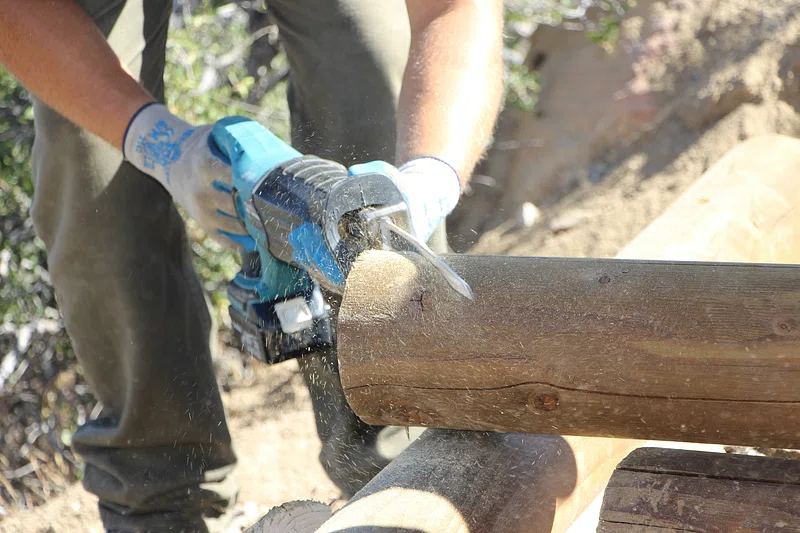Reciprocating Saw: Ultimate Guide and Tips
Key Takeaways:
- Get to know the ins and outs of using a reciprocating saw.
- Learn how to select the right saw for your project needs.
- Discover essential features and cutting techniques.
- Understand the importance of safety and proper maintenance.
- Gain insights into the latest advancements in reciprocating saw technology.
Diving Into Reciprocating Saw Basics

Defining the Reciprocating Saw
Imagine a tool that can make quick work of cutting through wood, metal, and even PVC. That’s your reciprocating saw. It’s the go-to power tool for demolition and remodeling, thanks to a blade that moves back and forth—hence the name ‘reciprocating.’
Versatility in Materials: What Can You Cut?
From slicing through old pipes to pruning tree branches, this saw is a powerhouse. It’s not just about cutting wood; swap out the blade, and you’re ready to tackle metal, fiberglass, or even tile.
Selecting Your Reciprocating Saw

Comparing Corded and Cordless Models
When it comes to power, you have two choices: corded or cordless. Corded saws offer consistent power without the worry of a dying battery. But if you need mobility, cordless is your best bet.
Understanding Stroke Length and Speed
Stroke length matters because it determines how much material you cut with each pass. A longer stroke means faster cutting. Speed, measured in strokes per minute (SPM), also plays a role in how quickly you can work through different materials.
Important Features to Look For
Most importantly, don’t overlook these must-have features:
- Blade Lock Systems: Quick and tool-free blade changes save time and hassle.
- Adjustable Shoe: This feature allows you to control the depth of the cut and extends blade life.
- Orbital Action Versus Traditional: Orbital action moves the blade in an elliptical pattern for faster, more aggressive cuts.
Powering Up: Battery and Motor Essentials
Let’s talk power. Your saw’s muscle comes from its motor, and if you’re going cordless, the battery platform is key. You’ll see voltages ranging from 12V for light work to 18V or more for heavy-duty tasks.
- Battery platforms determine compatibility with other tools you might own.
- Amp-hours (Ah) and watt-hours (Wh) indicate battery capacity and how long it’ll last on a charge.
Brushless Motor Advancements
Brushless motors are the latest tech in reciprocating saws. They’re more efficient, offer longer life, and don’t require as much maintenance as traditional motors.
Ergonomics and Usage Comfort
Because comfort is key, look for a saw with a good grip and low vibration. Anti-vibration features can make a big difference in how you feel after a day of cutting.
Anti-Vibration Technologies
Some saws come with specialized technology to reduce shake, which means less fatigue for you.
Grip and Trigger: Ensuring Comfort and Control
A rubberized grip and an easy-to-use trigger will give you better control and comfort, especially during extended use.
Sawing Techniques and Safety Tips
Before you start cutting, get familiar with these techniques to make your job easier and safer.
Effective Cutting Strategies
Whether you’re cutting a straight line or tackling a tough material, the right approach can save time and effort.
- Use the shoe of the saw as a pivot point for stability.
- Start slow to create a groove before increasing speed.
Plunge Cuts and Demolition Tips
To make a plunge cut, tilt the saw so the blade’s tip touches the material, then gently push forward while starting the saw.
Variable Speed and Material Specifics
Adjust your speed based on the material. Slow and steady for metals, faster for wood. Always use the appropriate blade for the material you’re cutting.
Maximizing Safety: Protective Gear and Best Practices
Safety first. Always wear eye protection, hearing protection, and heavy-duty gloves. Keep your work area clear and ensure the blade is not touching anything before you start the saw.
Maintenance and Blade Longevity
Blade Types and Their Uses
Blades come in various shapes and sizes. Use bi-metal blades for metal, carbide-tipped for masonry, and coarse-toothed blades for wood.
- Bi-metal blades are flexible and less likely to break.
- Carbide-tipped blades can handle tougher materials.
- Coarse-toothed blades are perfect for fast, rough cuts in wood.
Caring For Your Saw and Blades
Keep your saw in top shape by regularly cleaning it and checking for wear. Store blades properly to avoid damage and ensure they’re sharp for your next project.
Special Considerations and Advanced Features
As you become more familiar with your reciprocating saw, you’ll start to appreciate the finer points that make all the difference.
Ace Hardware: High-Tech Reciprocating Saws
High-tech models might come with features like programmable settings through an app or brushless motors that adjust to the task at hand—features that can streamline your work and extend the life of your saw.
Illuminating the Cut: LED Lights and Visibility
Good lighting is crucial, especially in tight spots. Many modern saws come with built-in LED lights that help you see exactly where you’re cutting, reducing mistakes and increasing safety.
Case Studies: Real-World Applications
Nothing beats a real-world example to show the potential of a good reciprocating saw.
DIY Success Stories
I remember a friend who used a reciprocating saw to turn an old wooden pallet into a gorgeous garden planter. With the right blade and a bit of creativity, they transformed what would have been trash into a treasure.
Professional Uses in Trade Work
Professionals rely on these saws daily. A contractor I know once shared how a reciprocating saw saved hours on a job by quickly cutting through old plumbing during a bathroom remodel.
Wrap-Up: Matching Saw Features with Your Needs
Choosing the right reciprocating saw comes down to understanding the features that match your specific needs. Whether it’s the convenience of a cordless model or the power of a corded one, the right saw will make your projects more efficient and enjoyable.
Frequently Asked Questions
Can a Reciprocating Saw Replace Other Types of Saws?
While a reciprocating saw is incredibly versatile, it’s not always a replacement for other saws. It’s excellent for demolition and rough cuts but may not be the best choice for fine woodworking where precision is key.
Is a Corded or Battery-Powered Saw Better for My Project?
It depends on your project. If you need the freedom to move around without being tethered to an outlet, go for a battery-powered saw. For continuous power and heavier-duty tasks, a corded saw might be the better choice.
What Are the Safety Precautions I Should Take When Using a Reciprocating Saw?
Safety precautions include wearing protective gear, ensuring the blade is suitable for the material, and keeping the work area clear. Also, be aware of the potential kickback when the saw starts to cut.
How Do I Choose the Right Blade for Different Materials?
Choose a blade based on the material you’re cutting. For wood, use a coarse-toothed blade; for metal, a fine-toothed or bi-metal blade; and for masonry, a carbide-tipped blade.
- Wood: Coarse-toothed blade
- Metal: Fine-toothed or bi-metal blade
- Masonry: Carbide-tipped blade
What Maintenance Does My Reciprocating Saw Require?
Regular maintenance includes cleaning the saw, lubricating moving parts, and checking for wear and tear. Properly store your blades and keep them sharp to ensure your saw is always ready for the next job.




